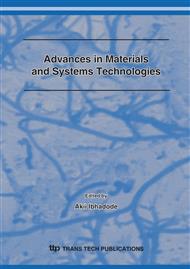[1]
EuroCommerce (2004), The Use of LCA's On Plastic Bags in an IPP Context, Environment and Logistics Report http: /www. eurocommerce. be.
Google Scholar
[2]
Brent A, Sevitz J, Fourie B, 'An Environmental Comparison Of Plastic And Paper Consumer Carrier Bags In South Africa: Implications For The Local Manufacturing Industry, Department of Engineering and Technology Mangement, University of Pretoria.
DOI: 10.7166/14-1-299
Google Scholar
[3]
Tan R, Culaba A, Environmental Life-Cycle Assessment: A Tool for Public and Corporate Policy Development.
Google Scholar
[4]
UNEP/SETAC Life Cycle Initiative (2003), Life Cycle Inventory Program of The Life Cycle Initiative, Draft Final Report of the LCI Definition Study. Corresponding address: gnorris@hsph. harvard. edu.
DOI: 10.1065/lca2007.10.363
Google Scholar
[5]
ISO (1998), Environmental Management - Life Cycle Assessment - Goal and Scope Definition and Inventory Analysis, ISO 14041, International Organisation for Standardisation, Geneva.
DOI: 10.3403/02057237
Google Scholar
[6]
ISO (2000a), Environmental Management - Life Cycle Assessment - Life Cycle Impact Assessment, ISO 14042, International Organisation for Standardisation, Geneva.
DOI: 10.3403/02947441u
Google Scholar
[7]
ISO (2000b), Environmental Management - Life Cycle Assessment - Life Cycle Interpretation, ISO 14043, International Organisation for Standardisation, Geneva.
DOI: 10.1007/bf02979166
Google Scholar
[8]
ISO (1997), Environmental Management - Life Cycle Assessment - Principles and Framework, ISO 14040, International Organisation for Standardisation, Geneva.
DOI: 10.1065/lca2005.03.001
Google Scholar
[9]
Lebel L, (2005) Transitions to Sustainability in Production-Consumption Systems, Industrial Ecology in Asiac _ 2005 by the Massachusetts Institute of Technology and Yale University Volume 9, Number 1-2 http: /mitpress. mit. edu/jie.
Google Scholar
[10]
EPIC, (2002), A Fresh Look at the Options for Managing Plastic Packaging, Technical report Summary. www. plastics. ca/epic.
Google Scholar
[11]
PRé Consultants, (2006), Introductio n to LCA with SimaPro 7, www. pre. nl.
Google Scholar
[12]
Alsema A, Wild-Scholten J, (2005), Environmental life cycle inventory of crystalline silicon photovoltaic module production, Presented at Materials Research Society Fall 2005 Meeting, November 2005, Boston, USA.
DOI: 10.1557/proc-0895-g03-04
Google Scholar
[13]
Lee K, Inaba A, (2004), Life Cycle Assessment, Best Practices of ISO 14040 Series, Center for Ecodesign and LCA (CEL), Ajou University.
Google Scholar
[14]
Pflieger J, Fischer M, Kupfer T, Eyerer P, 2005 The contribution of life cycle assessment to global sustainability reporting of organisations, Management of Environmental Quality: An International Journal Volume 16 Number 2 2005 pp.167-179.
DOI: 10.1108/14777830510583182
Google Scholar
[15]
Laestadius S, Karlson L, (2001), Eco-efficient products and services through LCA in R&D/design,. Environmental Management and Health Volume 12 Number 2 2001 pp.181-191.
DOI: 10.1108/09566160110389870
Google Scholar
[16]
Brent A, (2004), Introduction to LCIA and LCM in South African Context, Department of Engineering and Technology Mangement, University of Pretoria.
Google Scholar
[17]
Five Winds International (2004), Life cycle Management, Tools and Concepts for Sustainability, http: /www. fivewinds. com/uploadedfiles_shared/LifeCycleManagement040127. pdf.
Google Scholar
[18]
APEC Secretariat (2004), CTI 12/2002T - Training Program on ISO 14000 Series Product Oriented Standards: EL, LCA & Dfe, http: /ecodesign. ajou. ac. kr.
Google Scholar
[19]
MBDC, (2002) Design Challenge for E-Commerce Shipping Packaging and Logistics Cradle to Cradle Design Guidelines, 2002, MBDC. http: /www. mbdc. com.
DOI: 10.1039/9781849737234-00067
Google Scholar
[20]
Carlson R, Pålsson A, (2001), First examples of practical application of ISO/TS 14048 Data documentation format, CPM Chalmers University Of Technology.
Google Scholar


